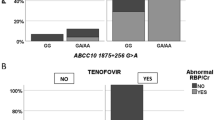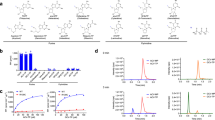Abstract
Recently, the use of antiretroviral drug tenofovir disoproxil fumarate (TDF) is increased, thanks to the new co-formulation with doravirine, the availability of booster-free regimens, and its advantageous lipid-lowering effect. The aim of our study was to identify genetic markers that contribute to assess the risk of TDF-related renal toxicity. We have retrospectively investigated, in 179 HIV positive patients treated with TDF, the association between the main variants in ABCC2, ABCC4, and ABCC10 genes and four safety endpoints, three clinically relevant as renal outcomes and a higher tenofovir plasma concentration. In patients with an annual eGFR decline >5 mL/min/1.73 m2 a difference in genotype frequencies was observed for ABCC10 c.1875 + 526 G>A (3 subjects AA vs. 44 GG + GA, p = 0.045). In patients with an eGFR decrement >25%, plus a decline in GFR category and TDF discontinuation, a difference was observed for ABCC4 c.*38T>G (35 subjects TG + GG vs. 18 TT, p = 0.052). At univariate analysis OR was 1.39 [(95% CI 1.00–1.96) p = 0.054] and at multivariate analysis OR was 1.49 [(95% CI 1.00–2.22) p = 0.049]. The stronger associations were found between the tenofovir accumulation and ABCC4 c.*38T>G and c.3348G>A: the percentage of these patients was higher in the TG + GG (p = 0.011) and in the AA (p = 0.004) genotype, respectively. The logistic regression analysis confirmed these significant relationships. No significant association was observed in patients with eGFR < 60 mL/min/1.73m2 and with the studied ABCC2 polymorphisms. Our results show a major role for a combined determination of ABCC4/ABCC10 variants as an indicator of tenofovir toxicity in the clinical practice.
This is a preview of subscription content, access via your institution
Access options
Subscribe to this journal
Receive 6 print issues and online access
$259.00 per year
only $43.17 per issue
Buy this article
- Purchase on Springer Link
- Instant access to full article PDF
Prices may be subject to local taxes which are calculated during checkout

Similar content being viewed by others
References
Wassner C, Bradley N, Lee Y. A review and clinical understanding of tenofovir: tenofovir disoproxil fumarate versus tenofovir alafenamide. J Int Assoc Provid AIDS Care. 2020;19:2325958220919231. https://doi.org/10.1177/2325958220919231.
EACS. Guidelines, version 10.0, 2019. https://www.eacsociety.org/files/2019_guidelines-10.0%20final.pdf.
US HIV treatment guidelines. https://aidsinfo.nih.gov/guidelines/html/1/adult-and-adolescent-arv/0.
Kauppinen KJ, Kivelä P, Sutinen J. Switching from tenofovir disoproxil fumarate to tenofovir alafenamide significantly worsens the lipid profile in a real-world setting. AIDS Patient Care STDS. 2019;33:500–6. https://doi.org/10.1089/apc.2019.0236.
Hill A, Hughes SL, Gotham D, Pozniak AL. Tenofovir alafenamide versus tenofovir disoproxil fumarate: is there a true difference in efficacy and safety? J Virus Erad. 2018;4:72–9.
Pilkington V, Hughes SL, Pepperrell T, McCann K, Gotham D, Pozniak AL, et al. Tenofovir alafenamide vs. tenofovir disoproxil fumarate: an updated meta-analysis of 14 894 patients across 14 trials. AIDS. 2020;34:2259–68. https://doi.org/10.1097/QAD.0000000000002699.
FDA. Integrated review for Pifeltro and Delstrigo approval. 2018. https://www.fda.gov/media/128270/download.
EMA. Assessment report for Delstrigo. 2018. EMA/874672/2018. https://www.ema.europa.eu/en/documents/assessment-report/delstrigo-epar-public-assessment-report_en.pdf.
Pham HT, Xiao MA, Principe MA, Wong A, Mesplède T. Pharmaceutical, clinical, and resistance information on doravirine, a novel non-nucleoside reverse transcriptase inhibitor for the treatment of HIV-1 infection. Drugs Context. 2020;9:2019-11-4. https://doi.org/10.7573/dic.2019-11-4.
Boyle A, Moss CE, Marzolini C, Khoo S. Clinical pharmacodynamics, pharmacokinetics, and drug interaction profile of doravirine. Clin Pharmacokinet. 2019;58:1553–65. https://doi.org/10.1007/s40262-019-00806-9.
Moss DM, Neary M, Owen A. The role of drug transporters in the kidney: lessons from tenofovir. Front Pharmacol. 2014;5:248. https://doi.org/10.3389/fphar.2014.00248.
Kohler JJ, Hosseini SH, Hoying-Brandt A, Green E, Johnson DM, Russ R, et al. Tenofovir renal toxicity targets mitochondria of renal proximal tubules. Lab Investig. 2009;89:513–9. https://doi.org/10.1038/labinvest.2009.14.
Rodríguez-Nóvoa S, Labarga P, Soriano V, Egan D, Albalater M, Morello J, et al. Predictors of kidney tubular dysfunction in HIV-infected patients treated with tenofovir: a pharmacogenetic study. Clin Infect Dis. 2009;48:e108–16. https://doi.org/10.1086/598507.
Pushpakom SP, Liptrott NJ, Rodríguez-Nóvoa S, Labarga P, Soriano V, Albalater M, et al. Genetic variants of ABCC10, a novel tenofovir transporter, are associated with kidney tubular dysfunction. J Infect Dis. 2011;204:145–53. https://doi.org/10.1093/infdis/jir215.
Rungtivasuwan K, Avihingsanon A, Thammajaruk N, Mitruk S, Burger DM, Ruxrungtham K, et al. Influence of ABCC2 and ABCC4 polymorphisms on tenofovir plasma concentrations in Thai HIV-infected patients. Antimicrob Agents Chemother. 2015;59:3240–5. https://doi.org/10.1128/AAC.04930-14.
Calcagno A, Fiumanò M, Zugna D, Cusato J, Montrucchio C, Marinaro L, et al. Tenofovir disoproxil fumarate discontinuation for renal outcomes: any room for treatment personalization? Pharmacogenomics J. 2019;19:65–71. https://doi.org/10.1038/s41397-018-0064-y.
Calcagno A, Cusato J, Marinaro L, Trentini L, Alcantarini C, Mussa M, et al. Clinical pharmacology of tenofovir clearance: a pharmacokinetic/pharmacogenetic study on plasma and urines. Pharmacogenomics J. 2016;16:514–8. https://doi.org/10.1038/tpj.2015.71.
Anderson PL, Lamba J, Aquilante CL, Schuetz E, Fletcher CV. Pharmacogenetic characteristics of indinavir, zidovudine, and lamivudine therapy in HIV-infected adults: a pilot study. J Acquir Immune Defic Syndr. 2006;42:441–9. https://doi.org/10.1097/01.qai.0000225013.53568.69.
Rungtivasuwan K, Avihingsanon A, Thammajaruk N, Mitruk S, Burger DM, Ruxrungtham K, et al. Pharmacogenetics-based population pharmacokinetic analysis of tenofovir in Thai HIV-infected patients. Pharmacogenomics. 2017;18:1481–90. https://doi.org/10.2217/pgs-2017-0128.
Kiser JJ, Aquilante CL, Anderson PL, King TM, Carten ML, Fletcher CV. Clinical and genetic determinants of intracellular tenofovir diphosphate concentrations in HIV-infected patients. J Acquir Immune Defic Syndr. 2008;47:298–303. https://doi.org/10.1097/qai.0b013e31815e7478.
Kidney Disease: Improving Global Outcomes (KDIGO) CKD Work Group. KDIGO 2012 clinical practice guideline for the evaluation and management of chronic kidney disease. Kidney Int. 2013;3 Suppl.:1–150.
Rodríguez-Nóvoa S, Labarga P, D’Avolio A, Barreiro P, Albalate M, Vispo E, et al. Impairment in kidney tubular function in patients receiving tenofovir is associated with higher tenofovir plasma concentrations. AIDS. 2010;24:1064–6. https://doi.org/10.1097/QAD.0b013e32833202e2.
Poizot-Martin I, Solas C, Allemand J, Obry-Roguet V, Pradel V, Bregigeon S, et al. Renal impairment in patients receiving a tenofovir-cART regimen: impact of tenofovir trough concentration. J Acquir Immune Defic Syndr. 2013;62:375–80. https://doi.org/10.1097/QAI.0b013e31827ce4ee.
Ezinga M, Wetzels JF, Bosch ME, van der Ven AJ, Burger DM. Long-term treatment with tenofovir: prevalence of kidney tubular dysfunction and its association with tenofovir plasma concentration. Antivir Ther. 2014;19:765–71. https://doi.org/10.3851/IMP2761.
Levey AS, Stevens LA, Schmid CH, Zhang YL, Castro AF 3rd, Feldman HI, et al. A new equation to estimate glomerular filtration rate. Ann Intern Med. 2009;150:604–12. https://doi.org/10.7326/0003-4819-150-9-200905050-00006.
Cattaneo D, Minisci D, Baldelli S, Mazzali C, Giacomelli A, Milazzo L, et al. Effect of cobicistat on tenofovir disoproxil fumarate (TDF): what is true for TAF may also be true for TDF. J Acquir Immune Defic Syndr. 2018;77:86–92. https://doi.org/10.1097/QAI.0000000000001558.
Izzedine H, Hulot JS, Villard E, Goyenvalle C, Dominguez S, Ghosn J, et al. Association between ABCC2 gene haplotypes and tenofovir-induced proximal tubulopathy. J Infect Dis. 2006;194:1481–91. https://doi.org/10.1086/508546.
Ray AS, Cihlar T, Robinson KL, Tong L, Vela JE, Fuller MD, et al. Mechanism of active renal tubular efflux of tenofovir. Antimicrob Agents Chemother. 2006;50:3297–304. https://doi.org/10.1128/AAC.00251-06.
Dahlin A, Wittwer M, de la Cruz M, Woo JM, Bam R, Scharen-Guivel V, et al. A pharmacogenetic candidate gene study of tenofovir-associated Fanconi syndrome. Pharmacogenet Genom. 2015;25:82–92. https://doi.org/10.1097/FPC.0000000000000110.
Casado JL, Bañón S, Santiuste C, Serna J, Guzman P, Tenorio M, et al. Prevalence and significance of proximal renal tubular abnormalities in HIV-infected patients receiving tenofovir. AIDS. 2016;30:231–9. https://doi.org/10.1097/QAD.0000000000000901.
Prodan Žitnik I, Černe D, Mancini I, Simi L, Pazzagli M, Di Resta C, et al. Behalf of EFLM/ESPT working group of Personalised Laboratory Medicine on. Personalized laboratory medicine: a patient-centered future approach. Clin Chem Lab Med. 2018;56:1981–91. https://doi.org/10.1515/cclm-2018-0181.
Funding
This study was carried out as part of our routine work, and was not specifically funded.
Author information
Authors and Affiliations
Corresponding author
Ethics declarations
Conflict of interest
The author declares no competing interests.
Ethical approval
Data used for this study were collected for clinical purposes and were previously anonymised, according to the requirements set by the Italian Data Protection Code (leg. decree 196/2003) and by the general authorizations issued by the Data Protection Authority. Approval by Ethics Committee was unnecessary because, under Italian law, such an approval is required only in the hypothesis of prospective clinical trials on medical products for clinical use (art. 6 and art. 9, leg. decree 211/2003). Each patient included in this study provided a written informed consent for genetic testing and publication of clinical data for research purposes.
Additional information
Publisher’s note Springer Nature remains neutral with regard to jurisdictional claims in published maps and institutional affiliations.
Rights and permissions
About this article
Cite this article
Cheli, S., Baldelli, S., De Silvestri, A. et al. ABCC4 single-nucleotide polymorphisms as markers of tenofovir disoproxil fumarate-induced kidney impairment. Pharmacogenomics J 21, 586–593 (2021). https://doi.org/10.1038/s41397-021-00235-7
Received:
Revised:
Accepted:
Published:
Issue Date:
DOI: https://doi.org/10.1038/s41397-021-00235-7
This article is cited by
-
An exploratory pharmacogenetic screening of SLC22A6, SLC22A8, ABCC4 and ABCC10 genes in a cohort of Ghanaian HBV patients
Egyptian Journal of Medical Human Genetics (2023)
-
Pathophysiological and Genetic Basis of Tenofovir-Induced Acute Renal Dysfunction: Strategies and Recent Developments for Better Clinical Outcomes
Current Pharmacology Reports (2022)



